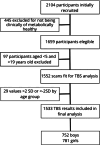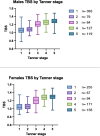Reference curves for trabecular bone score adjusted for soft tissue thickness in children and adolescents from Mexico City
- PMID: 40764421
- PMCID: PMC12325490
- DOI: 10.1007/s11657-025-01595-4
Reference curves for trabecular bone score adjusted for soft tissue thickness in children and adolescents from Mexico City
Abstract
This study proposes age- and sex-specific trabecular bone score (TBS) reference curves for Mexican children and adolescents. Using the latest software version, results highlight significant pubertal changes and provide reference data for assessing pediatric bone health, paving the way for a wider use of this technology in children and adolescents.
Purpose: Trabecular Bone Score (TBS) is a grey scale texture measure that correlates with bone microarchitecture derived from dual-energy X-ray absorptiometry (DXA). While extensively studied in adults, limited data exist for pediatric populations. This study aims to develop age- and sex-specific reference curves for TBS adjusted for abdominal soft tissue thickness in healthy children and adolescents from Mexico City.
Methods: This cross-sectional study reanalyzed data from 1552 healthy participants (5-18 years) who underwent lumbar spine DXA scans using Lunar iDXA and TBS iNsight 4.0 (Core Module 19.4.0), which accounts for soft tissue thickness. Generalized Additive Models for Location, Scale, and Shape (GAMLSS) were employed to construct smoothed percentile curves. TBS values were stratified by age, sex, and Tanner stage, with descriptive statistics and outlier exclusions.
Results: TBS showed distinct age- and sex-related trajectories, with steep increases during puberty. Girls demonstrated a sharper rise in TBS starting at age 9, peaking by age 16, while boys exhibited a more gradual increase starting at age 10-11, peaking by age 18. Differences were also observed between Tanner stages, with the most significant changes occurring from stages 2 to 3.
Conclusion: This study proposes the first TBS reference curves for Mexican children and adolescents using the latest software version. This data may prove to be a valuable tool for assessing bone health in pediatric populations. Yet further research to explore TBS's utility in predicting bone fragility in pediatric population as well as its life-course trends.
Keywords: Pediatrics; Puberty; Reference curves; Trabecular bone score (TBS).
© 2025. The Author(s).
Conflict of interest statement
Declarations. Conflicts of interest: Didier Hans is co-owner of the TBS patent and has corresponding ownership shares and position at medimaps group.
Figures



Similar articles
-
Trabecular bone score predicts distal femur screw pull-out strength better than DXA bone mineral density, CT Hounsfield units, and cortical density.Osteoporos Int. 2025 Jul;36(7):1249-1256. doi: 10.1007/s00198-025-07530-0. Epub 2025 May 28. Osteoporos Int. 2025. PMID: 40434688 Free PMC article.
-
Trabecular Bone Score in Individuals with Chronic Spinal Cord Injury: A Cross-Sectional Study.Top Spinal Cord Inj Rehabil. 2024 Fall;30(4):14-23. doi: 10.46292/sci24-00014. Epub 2024 Nov 28. Top Spinal Cord Inj Rehabil. 2024. PMID: 39619825 Free PMC article.
-
Trabecular bone score in the hip: a new method to examine hip bone microarchitecture-a feasibility study.Arch Osteoporos. 2022 Sep 20;17(1):126. doi: 10.1007/s11657-022-01168-9. Arch Osteoporos. 2022. PMID: 36125566 Free PMC article. Clinical Trial.
-
Nutritional interventions for survivors of childhood cancer.Cochrane Database Syst Rev. 2016 Aug 22;2016(8):CD009678. doi: 10.1002/14651858.CD009678.pub2. Cochrane Database Syst Rev. 2016. PMID: 27545902 Free PMC article.
-
Effectiveness and safety of vitamin D in relation to bone health.Evid Rep Technol Assess (Full Rep). 2007 Aug;(158):1-235. Evid Rep Technol Assess (Full Rep). 2007. PMID: 18088161 Free PMC article.
References
-
- Shawwa K, Arabi A, Nabulsi M, Maalouf J, Salamoun M, Choucair M et al (2015) Predictors of trabecular bone score in school children. Osteoporosis international : a journal established as result of cooperation between the European Foundation for Osteoporosis and the National Osteoporosis Foundation of the USA - PubMed
-
- Dowthwaite JN, Winzenrieth R, Binkley N, Krueger D, Scerpella TA (2017) A focused evaluation of lumbar spine trabecular bone score in the first year post-menarche. Arch Osteoporos 12(1):90 - PubMed
-
- Kalkwarf HJ, Shepherd JA, Hans D, Gonzalez Rodriguez E, Kindler JM, Lappe JM et al (2022) Trabecular bone score reference values for children and adolescents according to age, sex, and ancestry. Journal of bone and mineral research : the official journal of the American Society for Bone and Mineral Research 37(4):776–785 - PMC - PubMed
-
- Fraga MM, de Sousa FP, Szejnfeld VL, de Moura Castro CH, de Medeiros PM, Terreri MT (2023) Trabecular bone score (TBS) and bone mineral density (BMD) analysis by dual X-ray absorptiometry (DXA) in healthy Brazilian children and adolescents: normative data. Arch Osteoporos 18(1):82 - PubMed
MeSH terms
LinkOut - more resources
Full Text Sources
Medical

